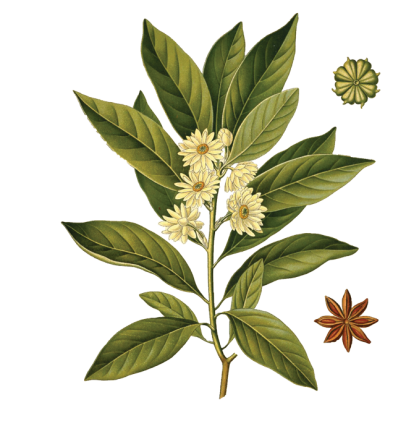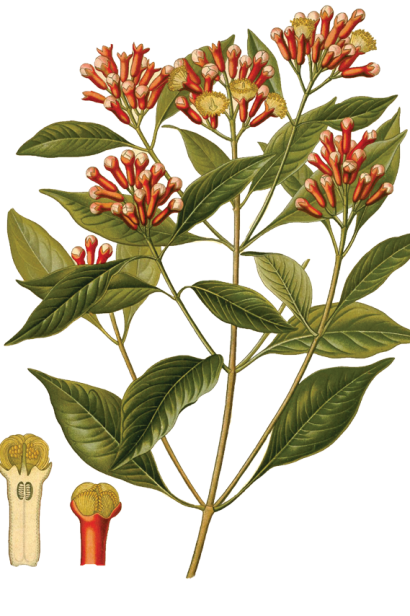A Season for Spices
Considering how the quest for exotic spices fueled exploration in the 15th century it is no wonder that our favorite holiday flavors hail from around the world. From Southwest India to Southeast Asia we find cinnamon, cloves, nutmeg, mace and ginger.
True cinnamon comes from the bark of Cinnamomum zeylanicum, an evergreen tree native to Southwest India. This is the premium cinnamon that is harvested just as new growth emerges from 2-year old stems. It has a light brown color and the interior of the quills (the curled strips) consists of several layers. Common cinnamon is harvested from Cinnamomum cassia; it has a darker color, stronger flavor and a more reasonable price!
Cloves come from the Maluku Islands in Indonesia. These so called “Spice Islands” were once the only source of nutmeg and mace. Cloves are the dried, unopened flowers of the tree Syzygium aromaticum. Nutmeg and mace come from the fruit of Myristica fragrans: the seed of the fruit is ground for nutmeg and the leathery, lacy seed covering is ground to produce mace. These spices are surprisingly nutritious. For example, nutmeg and mace contain flavonoid antioxidants and they have all kinds of trace minerals and vitamins. Additionally, all these spices promote healthy digestion and have antibacterial and antifungal properties, among other things. It’s an ingredient that packs a punch in more ways than one.
My favorite holiday spice is cardamom because I associate its distinct flavor with holiday trips to my grandparents’ house in LaGrange, Illinois. Nena would make a braided cardamom bread that I loved. I even replicated the recipe this year, much to my delight! She called it a coffee cake but it’s really a yeasted, aromatic bread (see her recipe; I have copied it verbatim). Cardamom is frequently used in Scandinavian baking so I was introduced to it as an early age. Cardamom is the seed from two species of plants. Green (or true) cardamom comes from Elettaria cardamom and black cardamom comes from the seeds of Amomum magnificum.
Perhaps the mightiest holiday flavor is found in ginger. Zingiber officinale is one of many species of this flowering tropical plant. It is native to Southeast Asia although most commercial ginger is grown in Australia, California and Jamaica. The edible ginger rhizome has properties that help aid digestion, ease motion sickness, stimulate circulation and act as an anti-inflammatory. Some insist that it is an aphrodisiac and strengthens both body and spirit. Above all, however, ginger acts as a natural preservative that made it a valuable commodity before the age of refrigeration. In fact, during medieval times, ginger was the second-most-traded spice after pepper. Its pungent flavor may have been why gingerbread first became a choice at the local bakery, too.
In the book Famine on the Wind, it is suggested that an inventive baker who was trying to save flour that had been spoiled by a grain fungus (Tilletia tritici) called stinking smut may have developed gingerbread. The smut caused the flour to be discolored and rancid, so the baker added a little molasses for sweetening and coloration and enough ginger to mask the fishy taste of the smut. History was made if, in fact, this is true. Another interesting note about smut: Historians now think that the Salem witch trials might have been partially a result of convulsive ergotism. Ergot poisoning from a poisonous fungus (Claviceps purpurea) that grows on rye causes convulsions, itching, blindness and other symptoms similar to what the women and children of 1692 Massachusetts exhibited. A study of weather patterns and grain production at the time suggest that conditions did indeed favor the rye fungus.
In medieval Europe gingerbread became a popular food item at bakeries and fairs where women would buy gingerbread “husbands,” believing that eating the gingerbread men would increase their chances of meeting a real potential husband! By the 17th century in England gingerbread bakers (as members of a professional bakers’ guild) had the exclusive right to produce the bread except on Christmas and Easter. This prohibition, except during the holidays, is likely why gingerbread is so closely associated with Christmas. Perhaps we should consider working all of these so-called holiday spices in more frequently throughout the year?
Gingerbread entered the mainstream consciousness in the 19th century when the Brothers Grimm published a collection of German tales including that of Hansel and Gretel and a house made of gingerbread. Children everywhere now had romantic notions about gingerbread houses, gingerbread men and women, and gingerbread cookies that remain today.
Ginger got its name from the Sanskrit word sringavera, which means “root shaped like a horn.” Spice ginger is the rhizome (root) of the plant and the signature hot and pungent flavor is more than just a taste sensation, it has a pretty good story to tell, as well. So, when you enjoy gingerbread treats this holiday season think of the rhizome, the smutty flour and the frugal baker.






